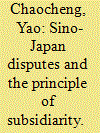|
|
|
Sort Order |
|
|
|
Items / Page
|
|
|
|
|
|
|
| Srl | Item |
| 1 |
ID:
127160


|
|
|
|
|
| Publication |
2014.
|
| Summary/Abstract |
Among natural gas producing nations, there has been some concern about how the Asia Pacific will meet future demand for energy. We argue that natural gas, both regional and global, will play a vital role. Estimates of potential gas consumption in the region are analyzed and used to develop consensus projections to 2030. These consumption profiles are compared with gas supply estimates including indigenous, pipeline and LNG for the Asia Pacific market. From this analytical framework, we find that demand will be sufficiently large to accommodate supplies from diverse sources including North America, the Middle East, Central Asia, Russia, and the Asia Pacific itself. An important policy implication is that gas producing and consuming nations should benefit from promoting gas trade and not be concerned about a situation of potential lack of demand coupled with oversupply.
|
|
|
|
|
|
|
|
|
|
|
|
|
|
|
|
| 2 |
ID:
092414


|
|
|
|
|
| Publication |
2009.
|
| Summary/Abstract |
Regional economic unification must overcome some economic obstacles, such as how to remove the trade and non-trade barriers, how to realise monetary stability in the region and how to develop a regional market, dominated by internal demand. However, in the long run, social obstacles will be more troublesome than the economic obstacles and could also be counterproductive. The integration process in Asia has been lagging behind the other continents of Europe and North America for many reasons. One of them is that the Asian unification process has mainly been a top-down approach by politicians and leaderships in this region, without wider and broader participation from the societies and civil groups. Nonetheless, there are strong trends favouring the ongoing regional cooperation in Asia. While envisioning bright prospects, the Asian economic integration process, however, is destined to encounter social obstacles. One of them is clearly the Sino-Japan dispute. The article argues, that the principle of subsidiarity (bottom-up approaches) (Horst Rolly 2003) being applied in European unification, may serve as the key solution-and strategic approach-to improve Sino-Japan relations. Asian nations, especially China and Japan, could draw on the lessons and experiences of European countries and adapt from their principle of subsidarity, which may serve to overcome the impending obstructions. Otherwise, the Sino-Japan dispute may become the largest barrier in building up the regional cooperation structure in Asia.
|
|
|
|
|
|
|
|
|
|
|
|
|
|
|
|
|
|
|
|
|